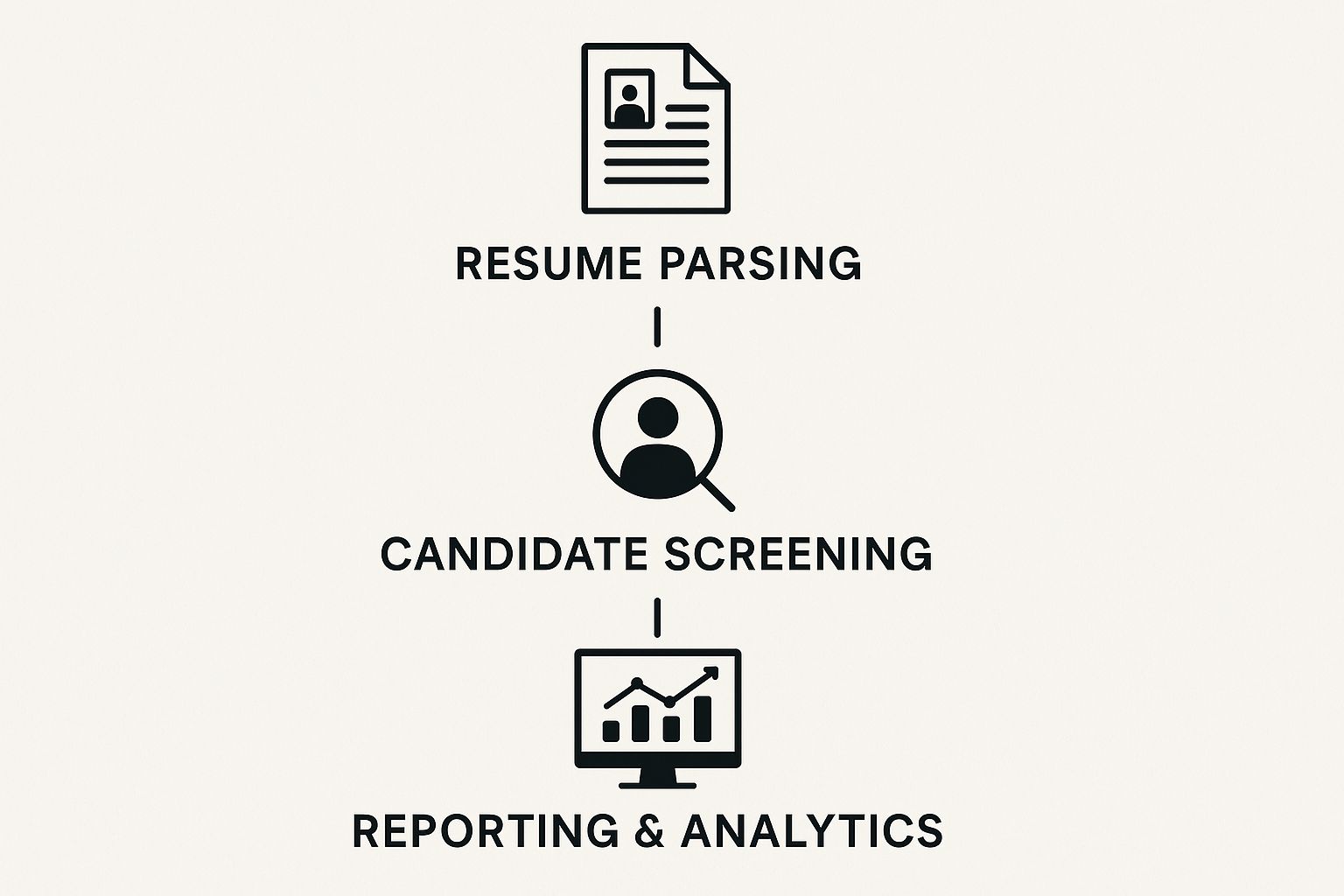August 18, 2025
Applicant Tracking Systems for Small Companies

If you're running a small company, you know that hiring can feel like a chaotic, all-consuming process. An applicant tracking system (ATS) is the software that brings order to that chaos. Think of it as your digital command center for everything related to recruitment, handling the entire process from posting a job all the way through to making an offer.
This kind of technology creates a central, organized database for all your candidate information. It’s the official end of managing hiring with messy spreadsheets and a bursting email inbox. For a small business, an ATS isn't just a nice-to-have; it's a game-changer that gives you back countless hours and helps you punch above your weight to attract top talent.
What Is an ATS and Why Do Small Companies Need One?

Picture your current hiring process. Is it a desk buried under piles of resumes, with sticky notes and confusing email threads everywhere? It’s incredibly easy for a great candidate’s information to get lost in that shuffle. An Applicant Tracking System (ATS) is the tool that cleans up this mess, turning a stressful, manual process into a smooth and professional workflow.
At its heart, an ATS is a software application built to manage the recruitment journey from beginning to end. It’s a single place where you can automatically collect, sort, and keep tabs on every single person who applies for a job. No more sifting through hundreds of emails or downloading resumes one by one—the system does all that heavy lifting for you.
From Manual Chaos to Automated Clarity
If you’re a small business without a big HR department, the benefits of an ATS become obvious almost immediately. The sheer amount of time spent on administrative hiring tasks is huge, and it pulls founders and managers away from growing the business. An ATS takes the most repetitive, time-sucking parts of hiring off your plate.
Here’s what it typically handles:
- Centralized Job Posting: With just one click, you can post your open roles to multiple job boards like LinkedIn, Indeed, and others.
- Automated Resume Parsing: The software automatically scans resumes, pulls out key details like skills and work history, and builds a clean, standardized profile for each candidate.
- Candidate Communication: You can set up automated emails to confirm applications and send status updates, so no one is left in the dark wondering where they stand.
This level of automation doesn't just save you time; it makes your company look incredibly professional. When applicants get prompt, clear communication, it drastically improves their experience and builds trust in your brand—even if you're just a small team.
An ATS isn't just about getting organized today. It's about building a scalable foundation for hiring tomorrow. It creates a searchable talent pool of every past applicant, which you can dip back into for future openings, saving you a ton of time and money on sourcing.
To really see why an ATS is so critical for small companies, it helps to understand the bigger picture of modern hiring. For a comprehensive look, you might want to check out a complete guide to effective recruitment. By automating the grunt work, an ATS levels the playing field, letting small businesses manage their hiring process like a much larger company and truly compete for the best people out there.
Key Benefits of an ATS for Small Business Growth

Bringing an applicant tracking system into your small business is about so much more than just tidying up your hiring. Think of it as a direct investment in your company's future. It clears the path for growth by giving you back your most precious resource: time.
Think about the old way of doing things. You spend hours manually posting a job ad on ten different websites. Then, your inbox explodes with applications, and you have to painstakingly sort through them while sending individual confirmation emails. An ATS takes all of that off your plate. It automates those repetitive, soul-crushing tasks, freeing up your team to focus on what really matters—like actually interviewing great people and planning your next business move.
This isn't just about moving faster. It's about building a consistent, professional hiring engine that hums along in the background.
Centralize Your Talent Intelligence
Right now, where does your candidate information live? If you're like most small businesses, it's probably scattered everywhere—in different email inboxes, a few messy spreadsheets, and maybe even some handwritten notes. This chaos is a recipe for missed opportunities and massive internal frustration.
An ATS fixes this by creating a single, organized hub for every piece of hiring data.
This centralized database means everyone on your team is looking at the same, up-to-the-minute information. No more losing a fantastic applicant in a cluttered inbox. No more confusion. Just seamless collaboration.
- Better Teamwork: Everyone can see candidate profiles, share notes, and track an application's progress in real time.
- Smarter Decisions: With all your data in one spot, you can finally see what's working and what's not. You can learn more about fine-tuning your strategy by reading our guide on how to improve recruitment process.
Enhance the Candidate Experience
First impressions count, especially when you’re a small company trying to attract top talent. This is where applicant tracking systems for small companies truly shine. They allow you to provide a polished, responsive experience to every single person who applies.
Automated messages ensure applicants get an immediate "we got it!" confirmation and are kept in the loop as they move through the process. That simple act of communication builds trust and makes your small business look like a seriously well-run operation. One of the best things an ATS can do is improve the candidate experience, which is absolutely critical for winning over the best people.
A strong candidate experience is a powerful competitive advantage. When top candidates feel respected and informed, they are more likely to accept an offer and speak positively about your company, regardless of the hiring outcome.
The numbers don't lie. Data shows that by 2025, over 45% of small businesses will be using an ATS. Why the rush? Well, 66% of hiring managers say it cut their time-to-hire by at least a week. On top of that, 52% reported a jump in candidate satisfaction thanks to better communication. It’s clear this technology isn't just a "nice-to-have" anymore; it's essential for any small business looking to grow.
Must-Have ATS Features for Small Companies
Not all applicant tracking systems are built the same, and this is especially true when you're a small company. It’s easy to get distracted by enterprise-level platforms packed with complex, expensive features you’ll simply never touch. The key is to zero in on a core set of tools that solve your immediate hiring headaches without adding a new layer of complexity for your team.
Think of it like outfitting a new workshop. You don't need every specialized, industrial-grade machine right away. What you really need are a few reliable, high-quality essentials that help you get the job done right, day in and day out. For a small business, the best features are all about getting the biggest impact from the least amount of effort.
This breakdown shows how the most essential ATS functions build on one another, starting with basic organization and leading all the way up to smarter, data-driven decisions.

As you can see, foundational features like resume parsing are the bedrock for more advanced capabilities, which ultimately give you the insights you need to hire better.
To help you cut through the noise, here's a quick-reference table of the absolute must-haves for any small business considering an ATS.
Essential ATS Features for Small Companies at a Glance
Think of this table as your initial shopping list. If an ATS is missing any of these core components, it's probably not the right fit for a growing business.
Core Functionality for Day-to-Day Hiring
Before you even think about fancy add-ons, make sure any potential ATS absolutely nails the fundamentals. These are the non-negotiable features that deliver the biggest return on your time and money right out of the box.
Your core feature checklist should look something like this:
- One-Click Job Posting: The power to post an open role to multiple job boards—like LinkedIn, Indeed, and niche industry sites—all at once is a game-changer. It’s a massive time-saver.
- A Simple User Dashboard: The system has to be easy to navigate from the get-go. A cluttered, confusing interface completely defeats the purpose of getting organized in the first place.
- Customizable Hiring Stages: Your hiring process isn't a carbon copy of someone else's. Your ATS should let you build a pipeline that mirrors your actual steps, whether that’s "Applied," "Phone Screen," "Team Interview," or "Offer."
These foundational tools are the engine of an effective ATS, handling the most repetitive and time-consuming parts of recruitment.
Automation and Communication Essentials
This is where an ATS really starts to work for you. By automating routine communication, the system frees you up to focus on what actually matters: building relationships with your top candidates. It allows a small team to project the kind of professional, organized image that attracts great talent.
Automated messaging is a perfect example. You should be able to create templates for instant application confirmations, polite rejection emails, and interview reminders. This simple step ensures no candidate is left in the dark, which dramatically improves their experience with your company. To see how this fits into the bigger picture, you can explore other powerful recruitment automation tools that help streamline your entire workflow.
A great ATS doesn’t replace human interaction; it automates the impersonal tasks so you have more time for meaningful, personalized engagement with your best applicants.
Crucial Integrations and Reporting
Finally, a modern ATS can't be an island. It has to connect smoothly with the tools your team already relies on every day. This is what prevents duplicate data entry and keeps everyone on the same page without constantly toggling between different apps.
At a minimum, look for these key integrations:
- Email and Calendar: Syncing directly with Google Calendar or Outlook for scheduling interviews is a must-have. No more endless email chains trying to find a time that works.
- Team Communication: Connections to platforms like Slack or Microsoft Teams mean your hiring manager can get quick feedback on a candidate without a formal meeting.
Don't forget about reporting, either. You don't need a data science degree, but basic dashboards are vital. Even simple reports showing your time-to-hire, the source of your best applicants, and any bottlenecks in your pipeline can provide huge insights. This data is what helps you make smarter hiring decisions and improve your process as your company grows.
How to Choose the Right ATS for Your Budget

Picking the right applicant tracking system can feel like a huge task, especially when you're working with a tight budget. But it doesn't have to be. With a clear plan, you can turn this chore into a smart investment for your company's future. The secret is to look past the sales pitches and focus on how a system will actually add value to your day-to-day hiring.
The best place to start is by sketching out your current hiring process from start to finish. Where are the biggest headaches? Maybe you’re sinking hours into posting jobs on multiple boards, or perhaps scheduling interviews has become an endless chain of back-and-forth emails. Identifying these specific bottlenecks helps you build a checklist of must-have features that will solve your real-world problems.
With that list in hand, you can figure out a realistic budget. The good news is that many of the best applicant tracking systems for small companies offer flexible pricing. You'll find everything from pay-per-job models to affordable monthly plans. Knowing what you can spend helps you zero in on the options that make financial sense.
Evaluate Your Top Contenders
Once you've narrowed it down to a few budget-friendly systems, it's time to get your hands dirty. Don't just read a list of features on a website—you need to see the software in action. Most companies offer free trials or live demos, and you should absolutely take them up on it. This is your chance to see how the system really feels.
During the trial, pay close attention to the user experience. Is it easy to navigate, even for someone who isn't a tech wizard? A confusing or clunky interface is a deal-breaker. If your team can't figure it out, they won't use it, and you'll have wasted your money. A clean, simple dashboard is essential for a small team. For a side-by-side look at how leading platforms compare, check out our detailed recruitment software comparison.
Use this time to ask some tough questions that will impact you down the road.
- Scalability: Can this system grow with us? Find out what happens to the price and features when you need to hire more people.
- Customer Support: What happens when things go wrong? Look for providers who offer responsive help through chat, email, or a phone call.
- Integrations: Will it play nice with the tools you already use? Make sure it can connect to your email calendar or team collaboration apps.
Look Beyond the Basics
The world of ATS software is always changing, and powerful new tech is becoming more affordable. In 2025, artificial intelligence (AI) has become a game-changer, giving small businesses access to tools that were once only available to giant corporations. AI-powered features can automatically screen resumes, help predict who your best candidates are, and even manage communications. Choosing a system with these modern capabilities can give you a serious advantage when trying to attract top talent.
Choosing an ATS isn't just about fixing today's hiring headaches; it's about building a foundation that will support your company as it grows. Focus on usability, support, and scalability to make sure you're getting a tool that will deliver a real, long-term return on your investment.
A Simple Guide to Implementing Your New ATS
So, you’ve picked out your new ATS. Great! But let’s be honest, a powerful tool is useless if your team doesn’t actually use it. A successful rollout is less about the technical nitty-gritty and more about smart planning and crystal-clear communication. The goal is to make the jump from messy spreadsheets to a clean, organized system feel like an obvious upgrade, not another frustrating task.
First things first: get your data house in order. Before you do anything else, you need to import your existing candidate database. Think of it like moving into a new, perfectly organized office; you wouldn't leave all your important files behind. Most modern applicant tracking systems for small companies have tools that let you bulk-upload resumes and contacts right from spreadsheets, making sure you start with a clean slate.
Tailor the System to Your Workflow
With your data loaded, it's time to customize. An out-of-the-box ATS is just a blank canvas. To make it truly powerful, you have to shape it to reflect how your company actually hires. Don't just stick with the default settings—they weren't made for you.
This means building out your custom hiring pipeline. Sit down and map out the exact stages a candidate moves through at your company. It might look something like this:
- Application Review: The first look at all incoming resumes.
- Phone Screen: A quick introductory chat with a recruiter or hiring manager.
- Team Interview: A deeper conversation with the folks they’ll be working alongside.
- Final Interview: The last discussion, usually with leadership.
- Offer Extended: The final step before a candidate says yes.
When you tailor the stages this way, you create a workflow that your team instantly recognizes. There's no learning curve or confusion; they can just jump in and get to work.
Key Takeaway: A successful ATS implementation is 90% process and 10% technology. Spend the time defining your hiring stages and training your team. The software will then naturally become the supportive tool it’s meant to be.
Get Your Team On Board
Finally, and this is the big one, you need to focus on adoption. You could have the best system on the planet, but it’s completely worthless if nobody ever logs in. Schedule a dedicated training session—even an hour is enough—to walk everyone through the new process. More importantly, show them how it makes their own lives easier, like automating interview scheduling or sending templated follow-up emails.
Tackle their concerns head-on and explain the "why" behind the switch. Frame the ATS as a tool that frees them from administrative headaches so they can focus on what they do best: finding and connecting with amazing people. A smooth rollout minimizes the disruption and makes sure your new ATS starts paying for itself from day one.
Common Questions About Small Business ATS
https://www.youtube.com/embed/23GBDJbtp9k
Even with all the benefits laid out, I get it. Bringing a new piece of software into your business can feel like a big step, and it's natural to have a few lingering questions. It’s smart to tackle those doubts head-on so you can feel confident in your decision.
Let's walk through some of the most common uncertainties I hear about applicant tracking systems for small companies.
One of the biggest hesitations is whether an ATS is really worth it if you only hire a few people a year. My answer is always a firm "yes." Think of it this way: even if you only hire occasionally, an ATS builds an organized talent pool you can dip back into for future roles. It also makes sure every single applicant gets a professional, consistent experience and helps you stay on the right side of hiring regulations.
Is an ATS Too Expensive or Impersonal?
The next question is almost always about money. A lot of small business owners see the term "ATS" and immediately think "expensive corporate software," but that's an outdated view. The market today is full of affordable options built specifically for small teams. Many offer flexible pay-per-job pricing or low monthly subscriptions that won't break the bank.
When you factor in the massive cost of a bad hire—not to mention all the administrative hours you get back—a good ATS pays for itself very quickly.
A common fear is that automation will make the hiring process feel cold and robotic. In reality, a great ATS does the opposite. By handling the repetitive, impersonal tasks like sending confirmation emails, it frees you to focus on meaningful, human interactions with your top candidates.
This means you actually have more time for personalized emails, engaging phone screens, and thorough interviews. The system takes care of the grunt work so you can build real relationships. Your process ends up feeling more personal, not less.
An ATS isn't just a database. It's a tool that lets a small team build a powerful, scalable hiring machine that's ready to go whenever you are. It’s an investment in efficiency and professionalism that pays off with every single person you bring on board.
Ready to transform your hiring process from manual chaos to AI-powered clarity? Klearskill analyzes resumes in seconds, delivering 95% match accuracy so you can focus on the best-fit candidates and close positions faster. Start hiring smarter today.
